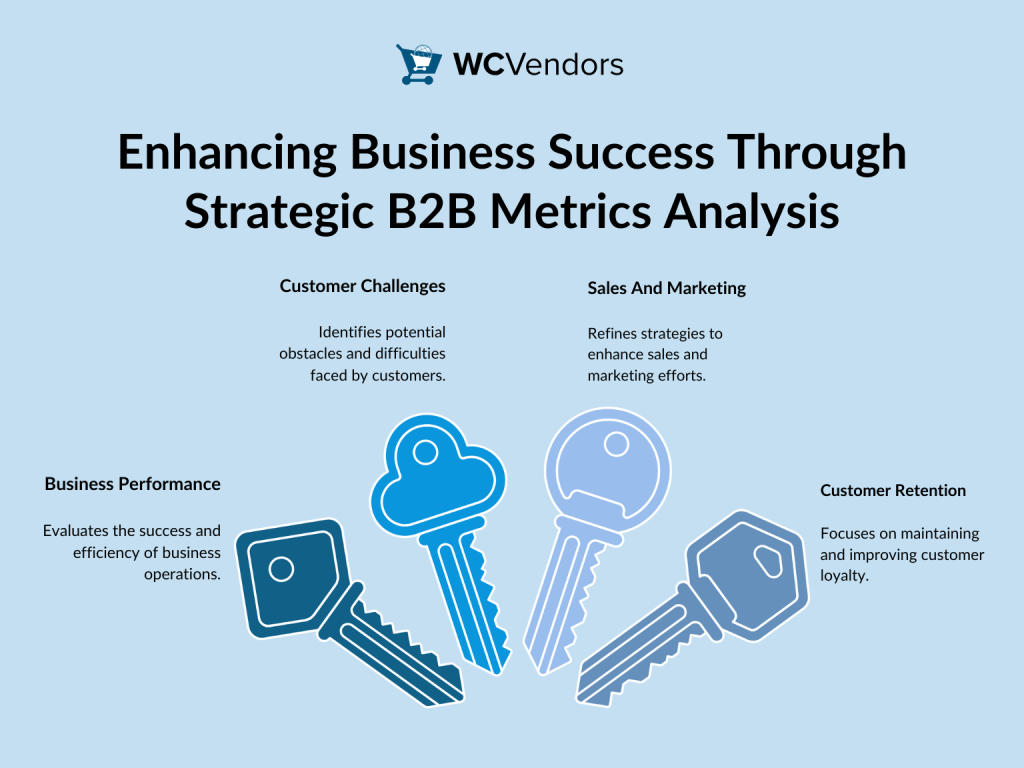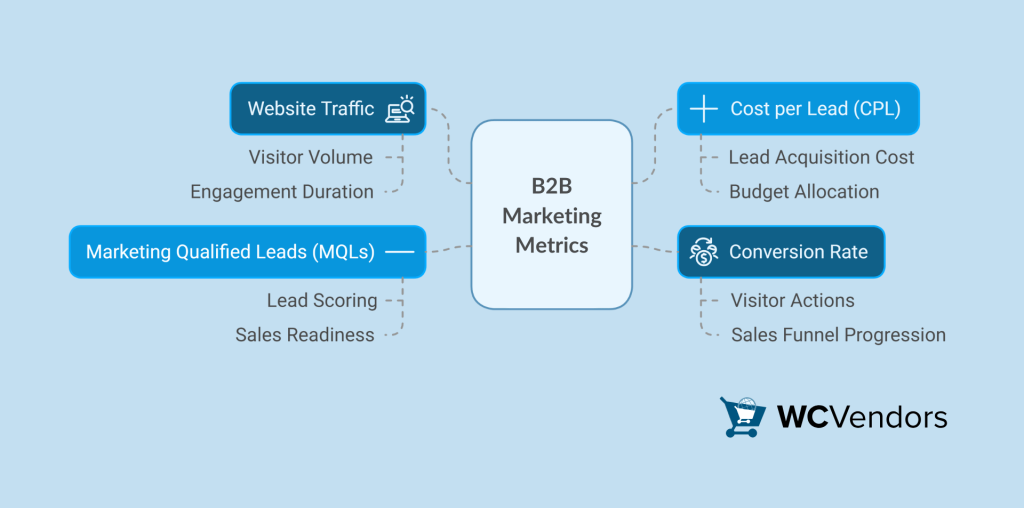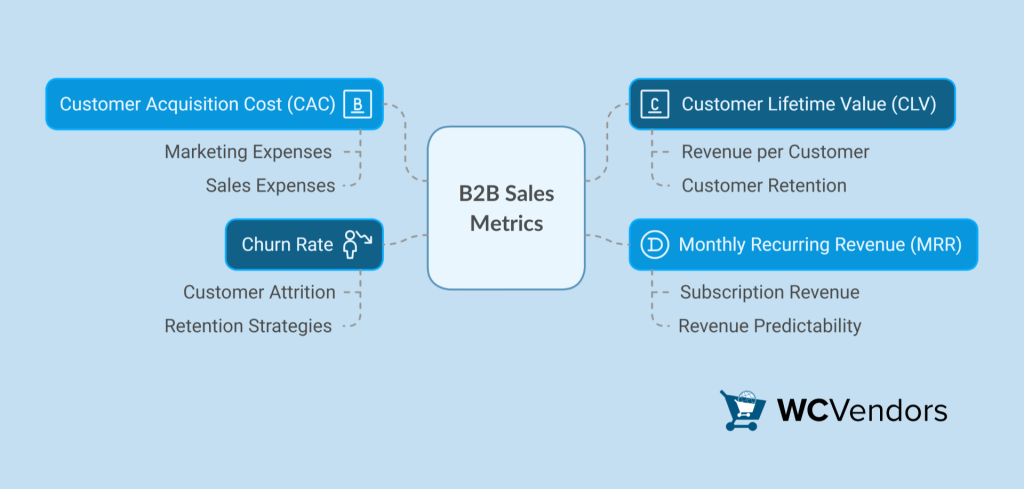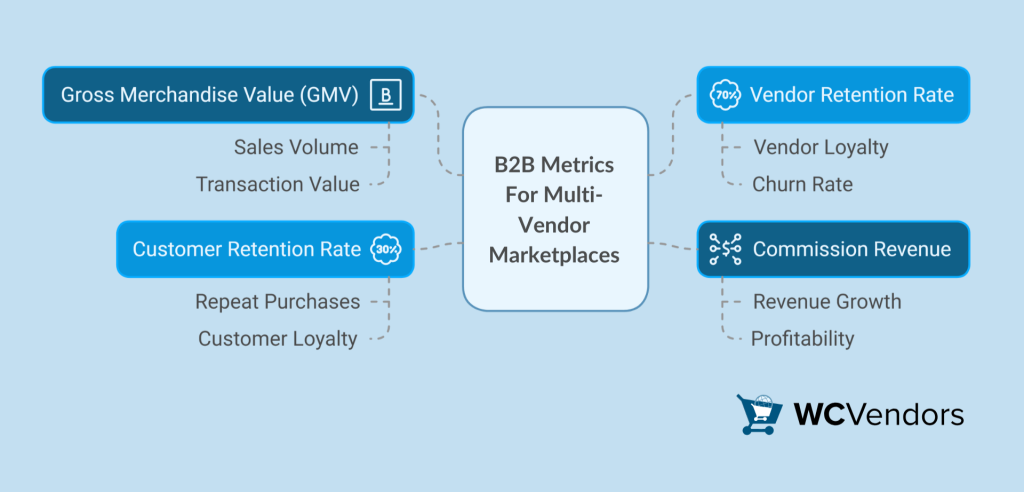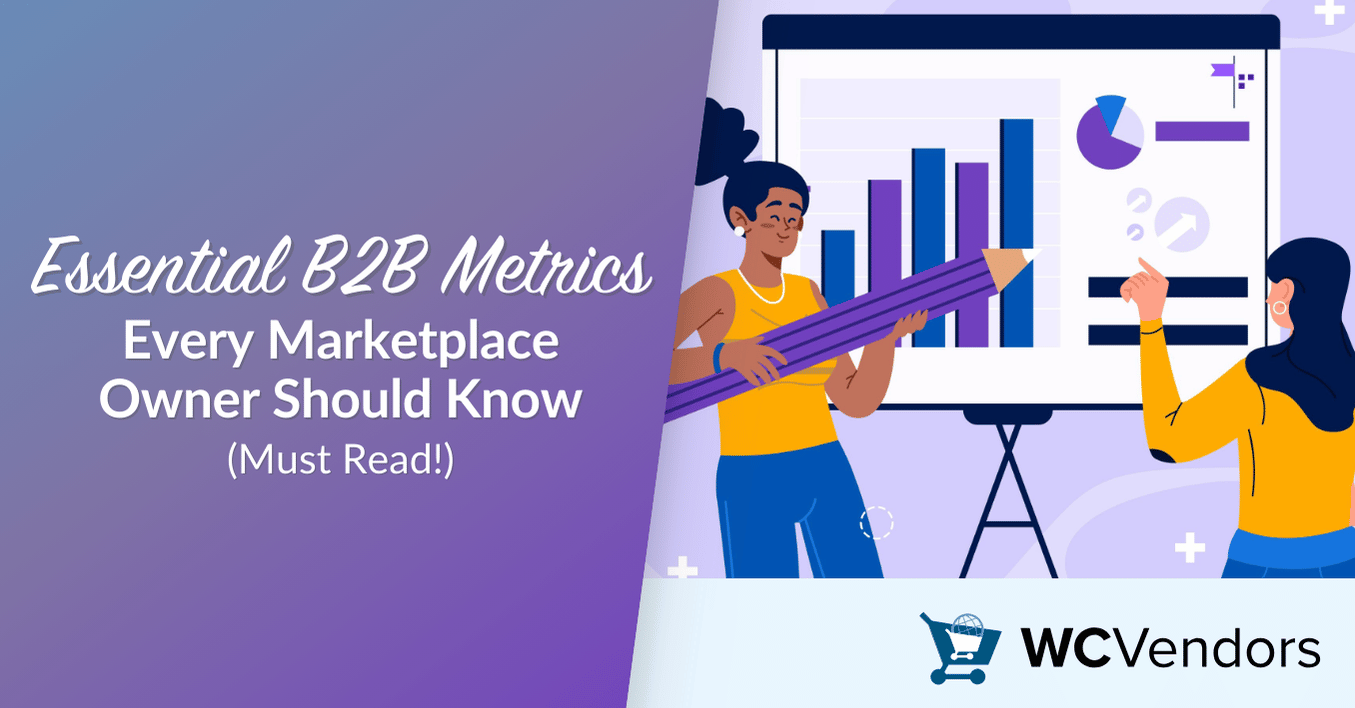
All great marketplace owners know that data is the key to business success, and it starts with tracking the right B2B metrics. For B2B marketplaces, where you’re catering to businesses rather than individual customers, these metrics help you measure performance, improve strategies, and grow sustainably.
But which metrics are the most important? And how can you ensure you’re measuring them correctly?
In this guide, we’ll cover the B2B metrics and KPIs that truly matter, how to measure them, and how to use them to boost your marketplace’s performance. By the end, you’ll have a clear understanding of how to track the metrics that drive growth, customer loyalty, and revenue!
What Are B2B Metrics?
B2B metrics are performance indicators that show how well your business is doing in areas like sales, marketing, customer retention, and growth. These are the metrics that matter because they give you actionable insights to improve your strategies and stay competitive.
Tracking these metrics helps you:
- See which areas of your business are performing well.
- Identify where your customers might be facing challenges.
- Refine your sales pipeline and marketing efforts.
- Improve customer retention and overall satisfaction.
It’s not just about looking at numbers. It’s about using those numbers to make smarter decisions and drive growth for your business.
Key B2B Marketing Metrics And KPIs To Track
Marketing is about attracting the right customers while making the most of every dollar you spend. But how can you tell if your efforts are actually working?
By tracking the right marketing metrics and KPIs, you can see what’s working, what needs to improve, and how to get the best results from your marketing investment. These numbers help you make smarter decisions to grow your marketplace.
Let’s look at the most important ones!
1. Website traffic
Your website is the heart of your marketplace. Tracking website traffic helps you understand how many people are visiting and how effective your marketing efforts are. For instance, if you notice spikes in traffic after launching a social media marketing campaign or running Google Ads, you can see what’s working.
2. Cost per lead (CPL)
Generating leads is critical, but how much are you spending to get each one? Tracking cost per lead ensures your marketing investment is paying off. Divide the total amount spent on a campaign by the number of leads it generated to calculate your CPL.
A high CPL could indicate inefficiencies in your email marketing or ad targeting. Adjusting strategies to lower CPL will help your sales team focus on more qualified leads.
How to calculate CPL
Divide the total marketing spend by the number of leads generated. For example:
- If you spend $1,000 on a campaign and generate 50 leads, your CPL is $20.
3. Conversion rate

Conversion rate measures the percentage of visitors or leads who take a specific action, such as signing up as a vendor or purchasing from one.
For example, if you’re running a campaign promoting customized products or seasonal offers, you’ll want to track how many visitors follow through. If your conversion rate is low, consider refining your landing pages or messaging.
How to calculate conversion rate
Divide the number of conversions by the number of visitors, then multiply by 100. For example:
- If 1,000 people visit a product page and 50 make a purchase, your conversion rate is 5%.
4. Marketing qualified leads (MQLs)
Marketing qualified leads are prospects who have shown strong interest in your marketplace and are more likely to convert. This metric aligns your marketing and sales efforts by ensuring the leads handed off to sales are ready to engage.
MQLs bridge the gap between marketing and sales, ensuring leads handed off to your sales team are ready to engage. Aligning on key performance indicators like MQLs improves collaboration and increases your chances of closing deals.
How to identify MQLs
- Set criteria such as job title, company size, or website actions like downloading a guide or visiting your pricing page.
By tracking these marketing metrics, you can attract more qualified leads and set your sales team up for success. Now, let’s explore the key sales metrics every marketplace owner should focus on.
Key B2B Sales Metrics To Track
Imagine this: you’re getting sales, but your revenue isn’t growing as much as you expected. Or, new customers are joining, but they’re not sticking around. Sound familiar?
This is where tracking the right sales metrics can make all the difference. These metrics give you the clarity you need to understand what’s really happening in your marketplace.
Let’s dive into the key B2B sales metrics every marketplace owner should track:
1. Customer Acquisition Cost (CAC)
Your customer acquisition cost is how much you’re spending to bring in a new vendor or customer. This metric is essential for understanding if your sales and marketing efforts are efficient and profitable.
A low CAC paired with a high customer lifetime value is the ideal scenario. If your CAC is too high, consider revisiting your sales pipeline or adjusting your marketing approach.
How to calculate CAC
Divide your total sales and marketing costs by the number of new customers acquired in a specific period. For example:
- If you spend $10,000 on marketing and gain 100 new customers, your CAC is $100.
2. Customer lifetime value (CLV)
CLV measures how much revenue a customer brings to your marketplace over their lifetime. For a marketplace, this might include fees from multiple purchases, vendor subscriptions, or recurring sales.
Improving customer retention rates directly increases CLV. Consider implementing loyalty programs or resolving complaints faster to keep customers coming back.
How to calculate CLV
Multiply the average purchase value by the number of purchases a customer makes and their retention duration.
For example:
- Average Purchase Value: $50
- Number of Purchases: 10
- Retention Duration: 2 years
CLV = $50 x 10 x 2 = $1,000
In this case, each customer brings $1,000 in revenue over their lifetime in your marketplace. By increasing retention or purchase frequency, you can boost this value significantly.
3. Monthly recurring revenue (MRR)
For marketplaces with a subscription-based model, like those using WC Vendors, tracking monthly recurring revenue is vital. MRR shows how much predictable income you can expect and helps you plan for the future.
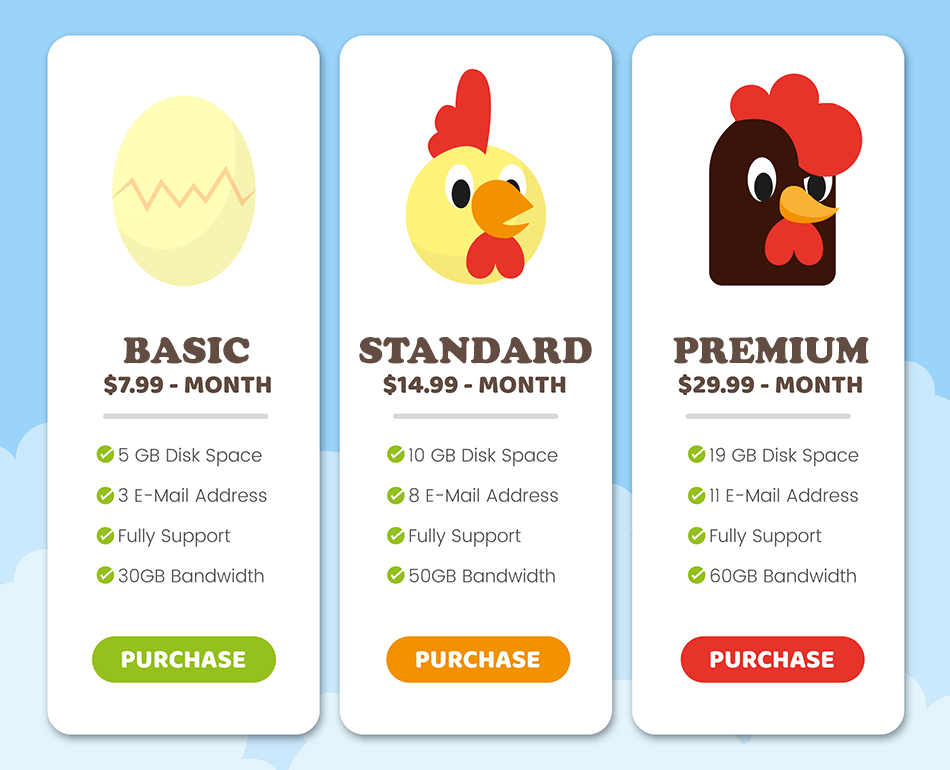
MRR provides financial stability and helps you plan for future growth. Regularly tracking MRR ensures you’re meeting your revenue goals and can identify trends, such as seasonal increases or decreases in subscriptions.
How to calculate MRR
Multiply the number of active subscribers by the average monthly subscription fee. For example:
- If you have 200 subscribers paying $25/month, your MRR is $5,000.
4. Churn rate
Your churn rate measures the percentage of customers or vendors who leave your marketplace over a specific time. This metric highlights whether your platform is retaining its users.
To reduce customer churn, consider improving your e-commerce security, optimizing your website’s speed, and making it easier for users to find what they need. A slow-loading site or a confusing interface can frustrate customers and drive them away. Additionally, address seasonal customer demands with tailored offers to keep them engaged and coming back.
How to calculate churn rate
Divide the number of customers lost during a period by the total number of customers at the start, then multiply by 100. For example:
- If you start the month with 400 customers and lose 20, your churn rate is 5%.
Understanding these sales metrics is essential for any business, but in a multi-vendor marketplace, things can get more complex. How do you know if your vendors are thriving or if your platform is delivering real value?
Let’s uncover the key metrics that matter most for multi-vendor marketplaces!
B2B Metrics For Multi-Vendor Marketplaces
Managing a multi-vendor marketplace means balancing the needs of both vendors and customers while keeping your business profitable. But how do you know if your marketplace is truly thriving?
Are vendors satisfied? Are customers coming back?
The answers lie in tracking the right metrics.
If you’re running a multi-vendor marketplace, these metrics will help you uncover what’s working, spot areas for improvement, and ensure your marketplace grows sustainably.
Let’s break down the numbers that matter most.
1. Gross merchandise value (GMV)
Gross Merchandise Value (GMV) measures the total value of all sales made through your marketplace. It gives you a clear view of how much business your marketplace generates and how well your vendors are performing.
How to calculate GMV
- Add up the total sales value of all orders placed on your marketplace. For example, if Vendor A sells $1,000, Vendor B sells $2,500, and Vendor C sells $3,000, your GMV is $6,500.
2. Vendor retention rate
Vendor Retention Rate measures how many vendors continue to use your marketplace over time. A high retention rate shows that vendors are satisfied with your platform, while a low rate may signal issues that need attention.
If vendors are leaving your platform, it’s time to evaluate your policies, fees, or vendor dashboard experience.
How to calculate vendor retention rate
Divide the number of vendors who stayed active during a period by the total number of vendors at the start of that period. Multiply by 100 to get the percentage. For example:
- If you started the year with 100 vendors and 90 are still active, your retention rate is 90%.
3. Commission revenue
This metric measures how much revenue your marketplace earns from vendor sales. It’s critical to track as it directly impacts your bottom line. Using WC Vendors Pro, you can customize commission rates to suit your marketplace’s needs. This includes incentivizing high-performing vendors or creating competitive fee structures.
How to calculate commission revenue
- Multiply the total value of vendor sales (GMV) by your commission rate.
- For example: If your GMV is $10,000 and you charge a 10% commission, your commission revenue is $1,000.
4. Customer retention rate
Customer Retention Rate measures how many customers continue to return to your marketplace. Retaining customers is vital for consistent sales and attracting more vendors to your platform. Happy customers not only bring repeat business but also attract more vendors.
How to calculate customer retention rate
Divide the number of returning customers by the total number of customers during a given period, then multiply by 100. For example:
- If 200 customers made purchases this month and 150 of them were repeat buyers, your retention rate is 75%.
Conclusion
Your marketplace’s success isn’t just about sales or traffic, it’s about understanding the numbers that drive your business forward. Tracking the right B2B metrics helps you grow your marketplace, keep your customers engaged, and support your vendors effectively.
These metrics go beyond basic data. They give you a clear picture of what’s working, what needs attention, and where your biggest opportunities lie.
If you’re running a multi-vendor marketplace with WC Vendors, focusing on these key metrics can unlock growth and improve your platform. By tracking what matters, you’ll create a marketplace where vendors and customers thrive together.
To recap, here’s what you need to focus on:
Key B2B Marketing Metrics and KPIs to Track:
Key B2B Sales Metrics to Track:
- Customer Acquisition Cost (CAC)
- Customer Lifetime Value (CLV)
- Monthly Recurring Revenue (MRR)
- Churn Rate
B2B Metrics for Multi-Vendor Marketplaces:
By tracking these essential metrics, you’ll have the insights you need to build a successful marketplace, keep vendors and customers happy, and grow your business sustainably.
Have any questions about how to implement these metrics in your marketplace? Let us know in the comments—we’d love to help!
